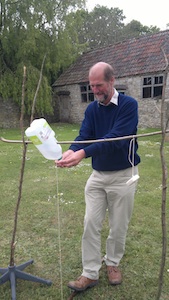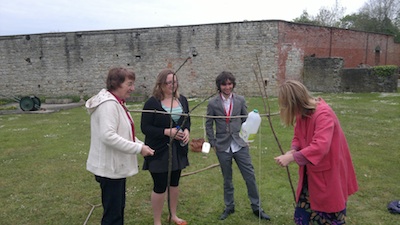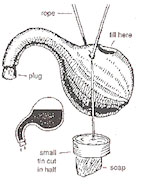| |
|
 |
ARC Staff construct a Tippy Tap
May 23, 2011:
 |
 |
 |
ARC’s Director Martin Palmer trials the newly constructed Tippy Tap (Note the use of the office chair base in the bottom left corner.) |
Tippy Tap is promoted as a simple device that can be built by anyone. To put this theory to the test, members of the ARC staff decided to build their own Tippy Tap during a lunch break.
The first task was to find four adequate sticks to use as the basic frame and foot lever. Then, to avoid digging up the grounds, some improvisation was required: So as to keep the vertical sticks for our frame ‘upright’, we managed to find the bases of two disused office chairs to act as supports for our frame.
When the frame had been secured in place, the team followed the rest of the instructions, (obtained from tippytap.org) using the few basic materials required such as string, a nail, a candle etc.
The finished product was surprisingly successful. The small hole made in the top of the container ensures that only the required amount of water is used and there is minimum wastage. On top of that, it really did allow for complete hand washing without touching anything except the bar of soap.
The only problem seemed to be that there has to be enough water in the container at all times to ensure that the weight keeps it upright when it is not in use.
It is important to note that it is only a short-term solution and not one that is introduced to replace the search for the development of sanitation facilities.
The Tippy Tap
Tippy Tap promotes hygiene: The fact that it is operated by foot lever means that the user only touches the soap, which further reduces the risk of transmitting bacteria.
Tippy Tap encourages water conservation: It uses only 40ml of water per hand wash, versus the 500ml of water required whilst using a mug. We also propose that wastewater can be collected in a container and be used to water plants.
Tippy Tap is adaptable: It can be made using local materials such as wood or bamboo. A conveniently shaped tree could also serve as the frame of your Tippy Tap.
Tippy Tap involves the community: It is so simple to construct that children can also get involved, which actively promotes the importance of hand washing.
How do you make a Tippy Tap?
To make a Tippy Tap you will need the following items:
• 2m long ‘forked’ sticks x2.
• 1m long straight sticks x2.
• Tools to dig (spade, pickaxe).
• Water container (Jerry can, bottle etc.)
• Gravel.
• A bar of soap.
• String (at least 3m in length).
• 1 nail.
• 1 Candle.
Instructions:
1. Dig two holes about 18 inches deep and about 1 metre apart.
2. Place the ‘forked’ sticks in the holes, ensuring that they are level.
3. Fill the holes with soil & rocks, pack tightly.
4. Using the candle, heat the nail, being careful not to burn your fingers!
5. Use the heated nail to make a hole through the soap. Thread the string through the hole in the soap and tie it so it’s secure.
6. Also use the heated nail to make two holes in your jerry can or bottle.
7. Place one of your 1m sticks across the top of the two vertical sticks.
8. Hang the bottle and soap on to the horizontal stick.
9. Fill your container with water.
10. Tie one end of a piece of string around the top of your container and the other end around the remaining stick (this will act as the foot lever).
11. Place gravel underneath the Tippy Tap to ‘soak up’ any excess water. A bowl could also be placed underneath in order to capture excess water, which could then be reused to water plants etc.
 |
 |
 |
Members of the ARC team get involved |
This is how you would make a standard Tippy Tap. However the design can be adapted to suit your surroundings. For example, you could hang your Tippy Tap from a suitably sized tree.
The cost of a Tippy Tap
If second hand materials are used, the Tippy Tap could end up costing nothing at all. It is estimated that if all materials are purchased new, the most a Tippy Tap would ever cost to build is US$4.
History of the Tippy Tap
 |
 |
 |
'Mukombe' - The first version of the Tippy Tap |
The first version of the Tippy Tap was designed by Dr. Jim Watt of the Salvation Army in Zimbabwe and was originally called the 'Mukombe'.
The design is now recreated in many forms and is most popular in Mozambique, Tanzania, Zambia and India.
It is also used and promoted by UNICEF and WaterAid in Uganda.
Tippy Tap Blog Story
The following extract is from an Internet blog. It is a lively and fun story about someone who helped to install a Tippy Tap in a school in Honduras.
The full article can be read here
…He should be use to my strange requests by now. Last week I asked to borrow pliers, a lighter and a nail. This probably sounds strangely masochistic, but I’m not crazy. It’s all the materials I need to build a Tippy Tap, a low-cost hand-washing device for places that don’t have access to running water. I’m creating one for a local elementary school that doesn’t have water. Last week I did a chat on hygiene and told a story of 3 friends and how they changed their habits. Normally these kids are off the wall crazy, but they love stories and so they actually paid attention, much to my delight. This week I’m going back and giving them the necessary tools to actually put into practice what they’ve learned.
A Tippy Tap is a very simple contraption; you need a big plastic jug, a rope and 3 sticks. Finding the sticks was surprisingly difficult. I bushwhacked through the forest for about an hour trying to find the right sticks; along the way I was greeted with more strange looks from passersby. I think it’s official, everyone in this town thinks I’m weird. I could see the burning questions in their eyes: What’s that white girl doing in this area? Do you think she’s lost? Why is she shuffling through the forest? Is that a machete in her hand? Should we make sure she’s ok?...
Web Links
Information for this article has been obtained from the following websites, which you can link to for further information:
• www.tippytap.org
• www.akvo.org
• YouTube link to award-winning Tippy Tap video.
|
 |
 |
|
|
|
|
|
 |
The organisation of ARC
ARC is administered by a small team of permanent staff and consultants. Our real strength lies in our networks, and in the people that each faith has appointed to work on environmental issues. |
 |
Projects overview
A complete listing of all current ARC projects |
 |
May 24, 2011:
Sikh Environment Day 2011 - how we all did it.
During the week of March 14th 2011, more than 450 Sikh temples (gurdwaras), schools, and organizations around the world participated in Sikh Environment Day. This is a very exciting start to an annual Sikh event that we believe will last and grow for many years. |
 |
 |
|
|

